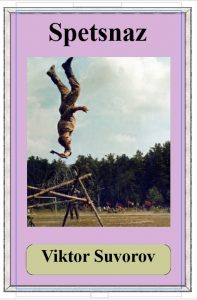EVERY INFANTRYMAN IN THE SOVIET ARMY CARRIES WITH HIM A SMALL SPADE. When he is given the order to halt he immediately lies flat and starts to dig a hole in the ground beside him. In three minutes he will have dug a little trench 15 centimetres deep, in which he can lie stretched out flat, so that bullets can whistle harmlessly over his head. The earth he has dug out forms a breastwork in front and at the side to act as an additional cover. If a tank drives over such a trench the soldier has a 50% chance that it will do him no harm. At any moment the soldier may be ordered to advance again and, shouting at the top of his voice, will rush ahead. If he is not ordered to advance, he digs in deeper and deeper.
At first his trench can be used for firing in the lying position. Later it becomes a trench from which to fire in the kneeling position, and later still, when it is 110 centimetres deep, it can be used for firing in the standing position. The earth that has been dug out protects the soldier from bullets and fragments. He makes an embrasure in this breastwork into which he positions the barrel of his gun. In the absence of any further commands he continues to work on his trench. He camouflages it. He starts to dig a trench to connect with his comrades to the left of him. He always digs from right to left, and in a few hours the unit has a trench linking all the riflemen’s trenches together. The unit’s trenches are linked with the trenches of other units. Dug-outs are built and communication trenches are added at the rear. The trenches are made deeper, covered over, camouflaged and reinforced. Then, suddenly, the order to advance comes again. The soldier emerges, shouting and swearing as loudly as he can.
The infantryman uses the same spade for digging graves for his fallen comrades. If he doesn’t have an axe to hand he uses the spade to chop his bread when it is frozen hard as granite. He uses it as a paddle as he floats across wide rivers on a telegraph pole under enemy fire. And when he gets the order to halt, he again builds his impregnable fortress around himself. He knows how to dig the earth efficiently. He builds his fortress exactly as it should be. The spade is not just an instrument for digging: it can also be used for measuring. It is 50 centimetres long. Two spade lengths are a metre. The blade is 15 centimetres wide and 18 centimetres long. With these measurements in mind the soldier can measure anything he wishes.
The infantry spade does not have a folding handle, and this is a very important feature. It has to be a single monolithic object. All three of its edges are as sharp as a knife. It is painted with a green matt paint so as not to reflect the strong sunlight.
The spade is not only a tool and a measure. It is also a guarantee of the steadfastness of the infantry in the most difficult situations. If the infantry have a few hours to dig themselves in, it could take years to get them out of their holes and trenches, whatever modern weapons are used against them.
